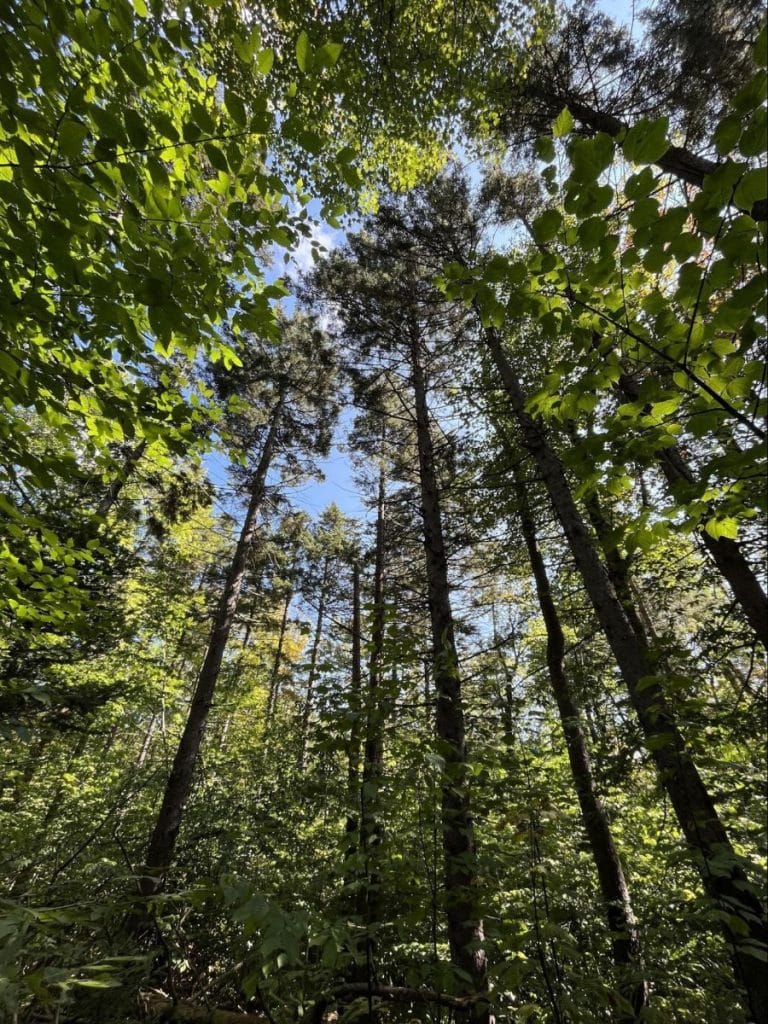The single largest property stewarded by The Trustees, Notchview, located in Windsor, Massachusetts, includes more than 3,100 acres of forests, wetlands, grasslands, early successional habitats and a high degree of regional forest connectivity. With an average elevation of approximately 2,000 feet, Notchview experiences a colder climate than much of the region, allowing for the existence of more northern species – and is threatened by the changing climate.
Working with Michael Mauri, a consulting forester, and the Northern Institute of Applied Climate Science Climate Adaptation Framework, land managers James Caffrey and Julie Richburg completed a landscape scale, climate change-informed forest management plan in 2018. The plan focused on the Trustees’ goals to manage Notchview’s forest habitats as a healthy, climate-resilient forest that provides diverse wildlife habitat and natural communities, as well as recreational opportunities to engage the public. The forest stewardship plan outlines the goals and objectives for managing the property’s natural resources, including how to address threats to forest resources such as non-native invasive species and those due to climate change. Although much of Notchview will be managed passively by supporting late-successional forest conditions, active management can be used to maintain and potentially increase the current diversity of native tree species.

The Trustees have identified climate change as a major challenge for the long-term management of Notchview. The region’s annual temperatures have risen more than 2°F, leading to a longer growing season and shorter, milder, and more variable winters. Changes in precipitation patterns are expected to alter hydrologic processes within forests and increase the risk of damage to infrastructure, like culverts, trails and roads. Active forest management efforts will be impacted by warmer and more variable winter conditions, which will reduce the number of days that heavy machinery will be able to operate on frozen ground. The changing climate is also expected to cause changes in forest species composition and health. Across the region, the habitat for many northern species is projected to decline as climate conditions become less suitable. Northern conifer species like red spruce and balsam fir are expected to be most vulnerable, particularly in more southerly parts of their range—including places like Notchview.
With nearly a million live trees, Notchview is covered by a diverse forest dominated by eleven tree species, most of which are shade tolerant. The most abundant species are red maple, yellow birch, beech and spruce, followed by sugar maple, black cherry, white ash and several other less common species for this region. These contribute to the overarching forest type of Spruce-Fir-Northern Hardwoods. This forest type typically occurs above 1400’ elevation (average elevation at Notchview is 2000’).
Notchview includes a variety of forests, wetlands, grasslands, and early successional habitats. The property’s size, particularly when considered with its continuity to the Windsor State Forest (>1,500 acres) and the Moran Wildlife Management Area (2,447 acres), provides a vast expanse of relatively unfragmented forest that is critical habitat for wildlife and forest-interior birds.
The property includes various wetland types and hydrology, including fast-running streams, beaver impoundments, forest seeps, vernal pools and large expanses of forested swamps, shrub swamps and sedge meadows. Large areas of grasslands, including hay fields, pastures and old fields, provide both valuable habitat for grassland wildlife and pastoral views. It is an important cultural, scenic and ecological landscape that is treasured by thousands of visitors and, as such, needs to consider public access and safety in keeping the property open to hikers, skiers and other recreationists.
The Climate Adaptation Forest Stewardship Plan has been completed. Recommendations from the plan are being targeted for implementation, beginning with a resiliency project that is funded by the Climate Adaptation Fund of the Wildlife Conservation Society and private philanthropy.
The goals of this current project are:
Julie Richburg
Lead Ecologist, Inland Natural Resources
The Trustees
Jrichburg@thetrustees.org
413.217.0509
Special thanks to Julie Richburg, Mike Mauri and Emily Boss for their assistance in preparing this case study.

Windsor
The land is in the town of Windsor, MA on unceded land of the Pocumtuc, Mohican and Nipmuc Nations and is stewarded by the Trustees. Learn more about whose land you’re on.
The Trustees of Reservations
Conservation Nonprofit
The Trustees, consulting foresters Michael Mauri, MA Department of Conservation and Recreation Forest Stewardship Program, Northern Institute of Applied Climate Science, Wildlife Conservation Society, Private Supporters
Develop and implement Forest Stewardship Climate Plan; increase climate resilience; enhance wildlife habitat; protect natural communities; preserve recreational opportunities
Invasives control; passive management for forest transition; targeted harvesting; herbivory control; monitoring plan
New England Forestry Foundation
|
Mass Audubon